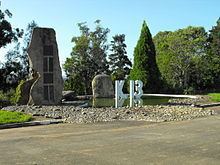Name HMS K13 Launched 11 November 1916 Draft 6.38 m | Ordered August 1915 Beam 26 ft 6 in (8.08 m) Length 103 m | |
 | ||
Fate Sold for scrapping 16 December 1926 in Sunderland Builder Fairfield Shipbuilding and Engineering Company | ||
An unlucky sub remembering the crew of hms k13
HMS K13 was a steam-propelled First World War K class submarine of the Royal Navy. She sank in a fatal accident during sea trials in early 1917 and was salvaged and recommissioned as HMS K22.
Contents
She had previously suffered another accident when heavy seas had damaged one of the funnels and water had nearly flooded her engine room. The damage had been repaired but the next one was far more serious.
Accident
She sank in Gareloch, Argyll, Scotland, on 29 January 1917 just after noon, having signalled to HMS E50 that she was about to dive. She had 80 people on board - 53 crew, 14 employees of the shipbuilders, five sub-contractors, five Admiralty officials, a River Clyde pilot, and the captain and engineering officer from the still-completing K14.
As she dived, seawater entered her engine room through openings which failed to close properly and flooded it along with the after torpedo room. As the submarine sank, a 10-ton ballast weight was dropped, but this did not arrest the descent. Two men were seen on the surface by a maid in a hotel a mile or so away, but her report was ignored. The crew of E50 became concerned when the submarine did not surface again, and found traces of oil on the surface.
The first rescue vessel, Gossamer, arrived at around 22:00 and divers were sent down at daybreak. The divers were delayed, since Gossamer had a diver but no suit, and the first diver to attempt to contact the submarine had a damaged suit which nearly flooded.
Morse code signals were exchanged between them and the trapped crew of the submarine. Despite the lack of proper escape apparatus, the captain, Lieutenant-Commander Godfrey Herbert, and the captain of K14, Commander Goodhart, attempted an escape to the surface by using the space between the inner and outer hatches of the conning tower as an airlock. Herbert reached the surface alive, but Goodhart's body was later found trapped in the superstructure.
Later that afternoon an airline was connected, which allowed the ballast tanks to be blown and with the aid of a hawser, and by midday on 21 January the bows had been brought to just above the surface and supported by a barge on each side. A hole was cut through her pressure hull, and at 22:00 the final survivor was rescued from the submarine, 57 hours after the accident. 32 crew died in the accident and 48 were rescued. 31 were expected to be still on the submarine, but only 29 were found, and it was concluded that the maid had indeed seen two people escaping from the engine room. One of their bodies was recovered from the Clyde two months later.
At 6 p.m. the following day, K13 tore the bollards out of the barges and sank again, flooding through the hole. The submarine was finally salvaged on 15 March, repaired and recommissioned as HMS K22.
The court of enquiry found that four of the 37 inch (940 mm) diameter ventilators had been left open during the dive, and that indicator lights in the control room had actually showed them as open. The engine room hatch was also found to be open.
HMS K5 was lost with all hands in January 1921, also due to problems with the air intakes that ventilate the boiler rooms.
The war graves and a monument to those who lost their lives in the K13 sinking was erected by the ship's company, of the submarine depot at Fort Blockhouse, Gosport. It is to be found at the entrance to Faslane Cemetery, at the head of the Gare Loch.
A memorial to the disaster was erected in Carlingford, New South Wales, Australia, paid for by the widow of Charles Freestone, a leading telegraphist on K13 who survived the accident to later emigrate and prosper in Australia. The memorial was unveiled on 10 September 1961 and has the inscription "This memorial has been created in memory of those officers and men of the Commonwealth who gave their lives in submarines while serving the cause of freedom." Set inside a pool of water surrounded by stone, it is composed of large (taller than a man) white letters saying "K13". It is called the "K13" memorial in particular memory of those lost in HM Submarine K13.
HMS K22
A year after the accident, as part of the 13th Submarine Flotilla, K13, now renamed K22 was involved in the "Battle" of May Island on 31 January 1918. This was during a night exercise in the Firth of Forth involving the flotilla, eight capital ships, and numerous cruisers and destroyers, and was a series of collisions which led to the loss of two K boats, serious damage to three others (including K22), and the deaths of a further 105 submariners.
